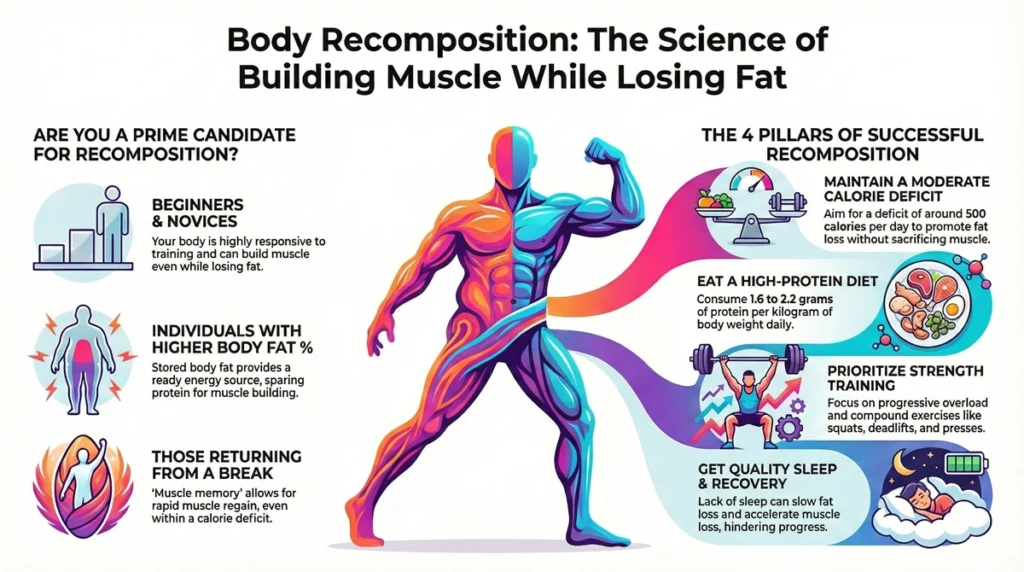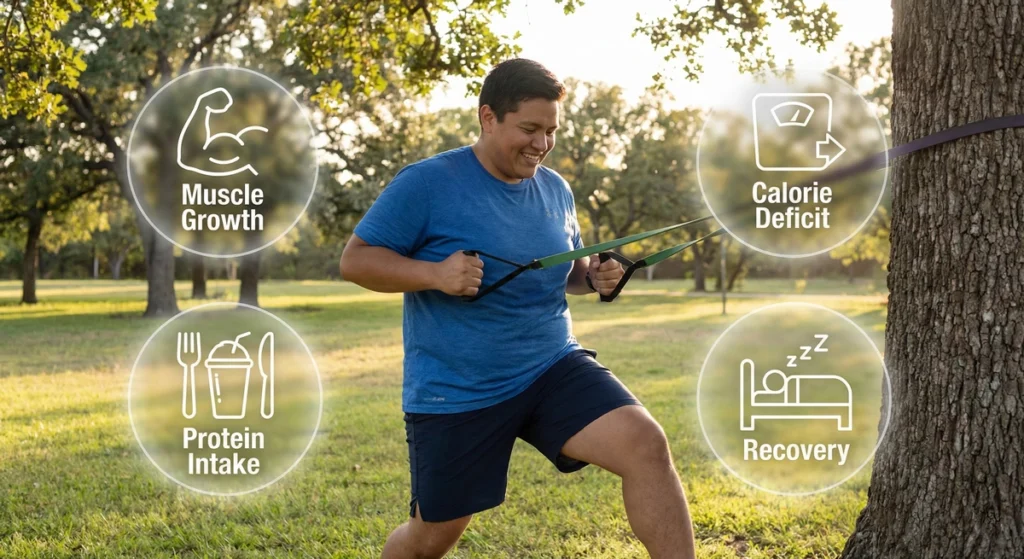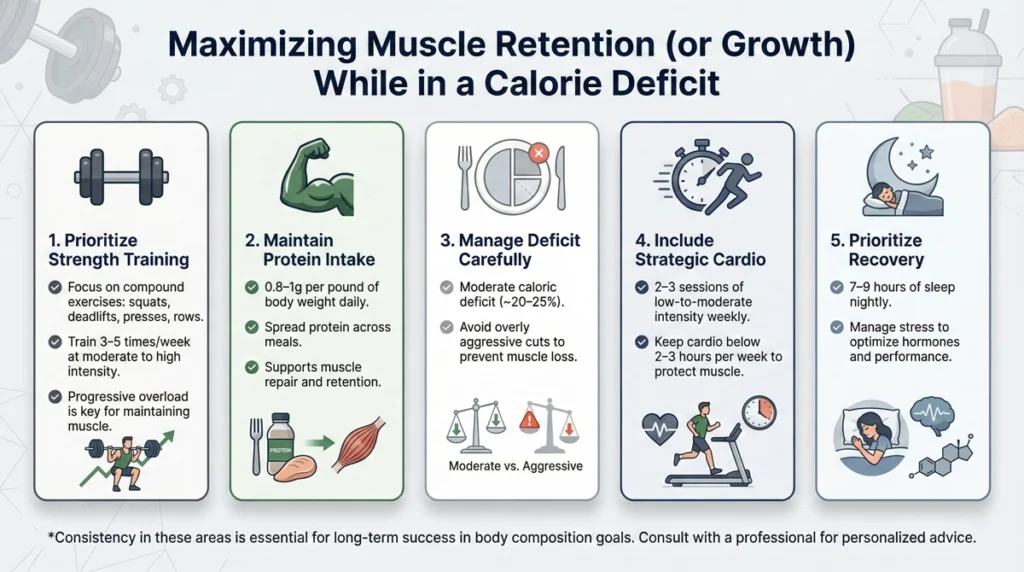Last winter, I found myself facing a common fitness dilemma. After a holiday season of indulgence, I was carrying some extra fat I wanted to lose, but I didn’t want to sacrifice the muscle I’d worked so hard to build. When I mentioned to my gym buddy Dave that I planned to cut calories while still trying to gain strength, he looked at me like I’d suggested defying gravity. “You can’t build muscle in a deficit, bro,” he said confidently. “It’s either bulking or cutting. Pick one.”
Dave’s perspective represents what many fitness enthusiasts believe: that building muscle and losing fat are mutually exclusive goals. Traditional bodybuilding wisdom has long held that you must choose either a calorie surplus to gain muscle (while accepting some fat gain) or a calorie deficit to lose fat (while accepting some muscle loss).
But is this really true? Can you actually build muscle while in a calorie deficit? After diving deep into scientific research, consulting with sports nutritionists, and experimenting with my own training, I discovered that the answer is more nuanced than most gym conversations would suggest.
- Understanding the Basics: What Happens in a Calorie Deficit
- The Science of Muscle Growth: Requirements and Limitations
- The Body Recomposition Phenomenon: When Building Muscle in a Deficit Is Possible
- Practical Strategies: How to Maximize Muscle Retention (or Growth) While in a Deficit
- Managing Expectations: What Results Are Realistic?
- Common Mistakes to Avoid When Trying to Build Muscle in a Deficit
- Special Populations and Considerations
- Tracking Progress: How to Know If You're Building Muscle While Losing Fat
- Real-World Results: Case Studies and Examples
Understanding the Basics: What Happens in a Calorie Deficit

Before tackling our main question, let’s establish what a calorie deficit actually means for your body. Put simply, a calorie deficit occurs when you consume fewer calories than your body burns through basic functions and physical activity. This negative energy balance forces your body to find alternative energy sources – primarily stored fat, which is essentially your body’s energy reserve.
When I tracked my own calories during a recent cutting phase, I aimed for about 500 calories below my maintenance level. At 3,100 calories maintenance, this meant consuming around 2,600 calories daily. Within a few weeks, the scale started moving downward at a rate of about a pound per week, confirming I was indeed in a deficit.
During a calorie deficit, several physiological processes occur:
- Your body increases the breakdown of fat stores (lipolysis) to use as energy
- Hormone levels shift – including decreases in anabolic hormones like testosterone and increases in catabolic hormones like cortisol
- Protein synthesis may be reduced compared to when in a caloric surplus
- Recovery capacity between workouts often diminishes
- Energy levels might decrease, affecting workout intensity
These factors create an environment that’s generally considered less than optimal for building new muscle tissue. But less than optimal doesn’t mean impossible.
The Science of Muscle Growth: Requirements and Limitations
Muscle growth (hypertrophy) occurs when muscle protein synthesis exceeds muscle protein breakdown over time. Three primary factors drive this process:
1. Progressive Tension Overload
Muscles need a reason to grow – specifically, exposure to greater tension than they’re accustomed to handling. This typically comes through progressive overload in training, where you gradually increase weight, reps, or training volume over time.
When I hit a plateau on bench press last year, my coach had me implement a simple but effective strategy: adding just 2.5 pounds to the bar each week. This micro-progression approach allowed me to keep increasing tension even while in a moderate calorie deficit.
2. Adequate Protein Consumption
Muscles are primarily made of protein, so building new muscle tissue requires sufficient protein intake. Research consistently shows that higher protein consumption (around 0.7-1.0 grams per pound of bodyweight daily) helps preserve and potentially build muscle, even in a deficit.
During my last cutting phase, I prioritized protein at every meal, aiming for at least 180g daily for my 180-pound frame. This meant lots of chicken breast, Greek yogurt, whey protein, and egg whites – not always exciting, but effective.
3. Recovery and Hormonal Environment
Your body needs to be in a state that permits recovery and growth. Factors like adequate sleep, stress management, and hormonal balance all play crucial roles in this process.
My worst muscle-building results always coincide with periods of poor sleep. During one particularly stressful work project, I was averaging just 5-6 hours of broken sleep nightly, and despite consistent training, my strength plateaued completely until my sleep improved.
The Body Recomposition Phenomenon: When Building Muscle in a Deficit Is Possible

Despite the challenges, research and real-world evidence confirm that building muscle while losing fat – known as body recomposition – is indeed possible under certain circumstances. Let’s explore the scenarios where you’re most likely to achieve this seemingly contradictory goal:
Scenario 1: Beginners and Returners to Training
Individuals who are new to resistance training or returning after a long break have what exercise scientists call “newbie gains” working in their favor. Their bodies are highly responsive to the novel stimulus of resistance training.
My friend Sarah, who had never lifted weights before, started a basic strength program while moderately reducing her calories to lose weight after pregnancy. Within three months, she had lost 18 pounds while increasing her squat from just the bar to 115 pounds for reps – clear evidence of both fat loss and muscle gain.
Research supports this observation. A 2016 study published in the American Journal of Clinical Nutrition found that untrained men were able to gain significant muscle while losing fat during a 4-week calorie deficit when combined with a high-protein diet and resistance training.
Scenario 2: Overweight or Obese Individuals
People with higher body fat percentages have a physiological advantage when it comes to simultaneous muscle building and fat loss. Their larger energy reserves (body fat) can be mobilized for fuel while protein and resistance training stimulate muscle growth.
A colleague who started his fitness journey at 285 pounds managed to lose over 50 pounds in a year while significantly increasing his strength across all major lifts. His body effectively used his abundant fat stores for energy while supporting muscle development through protein intake and progressive training.
Scenario 3: Those Taking Performance-Enhancing Substances
While not recommended or necessary, it’s worth acknowledging that certain substances can alter the natural physiological limitations of muscle building in a deficit. Anabolic steroids, for instance, can dramatically enhance protein synthesis regardless of caloric intake.
A natural lifter must be more strategic and patient when attempting body recomposition, recognizing that results will come more slowly than for enhanced athletes whose social media transformations often set unrealistic expectations.
Scenario 4: People Returning from a Layoff (Muscle Memory)
If you’ve previously built significant muscle that you later lost, your body can rebuild that muscle more quickly than developing it the first time – even in a calorie deficit. This phenomenon, often called “muscle memory,” involves both neural adaptations and cellular factors including myonuclear retention.
After a 3-month break from training due to a wrist injury, I lost noticeable muscle mass in my upper body. Upon returning to training, even while maintaining a slight deficit to shed the fat I’d gained during recovery, my muscles quickly returned to their previous size within about 6-8 weeks.
Practical Strategies: How to Maximize Muscle Retention (or Growth) While in a Deficit

If you’re determined to pursue the challenge of building (or at least maintaining) muscle while losing fat, certain evidence-based strategies can maximize your chances of success:
Strategy 1: Keep Your Deficit Moderate
The size of your calorie deficit significantly impacts your body’s muscle-building potential. The more severe your deficit, the more difficult building muscle becomes.
Recommended approach: Aim for a modest deficit of 300-500 calories below maintenance, which typically results in fat loss of 0.5-1 pound per week. This moderate approach preserves more of your body’s muscle-building capacity compared to more aggressive cuts.
When I tried a more extreme deficit of 1,000 calories daily during a previous cut, my strength dropped noticeably within two weeks. Switching to a more moderate 400-calorie deficit allowed me to at least maintain my strength, and in some exercises, continue making small improvements.
Strategy 2: Prioritize Protein Intake
Protein becomes even more critical during a calorie deficit, serving both to preserve existing muscle and provide building blocks for potential new growth.
Recommended approach: Consume 0.8-1.2 grams of protein per pound of bodyweight daily, spacing it relatively evenly throughout the day. For a 180-pound individual, this means roughly 145-215 grams of protein daily.
My personal approach includes four protein-focused meals daily:
- Breakfast: Greek yogurt with whey protein mixed in (40g protein)
- Lunch: Chicken breast with vegetables (35g protein)
- Post-workout: Whey protein shake (25g protein)
- Dinner: Lean ground turkey or fish (40g protein)
- Evening snack: Cottage cheese (20g protein)
This approach keeps me at around 160g daily while in a deficit, which has proven sufficient for maintaining my muscle mass.
Strategy 3: Maintain Training Intensity
One common mistake during calorie deficits is reducing training intensity to compensate for lower energy levels. However, maintaining intensity is crucial for signaling your body to preserve muscle tissue.
Recommended approach: Keep the weight on the bar high, even if you need to reduce overall volume (sets and reps) to accommodate your recovery capacity. Focus on compound lifts that engage maximum muscle mass.
During my recent cutting phase, I reduced my total weekly sets from about 20 to 15 per muscle group, but maintained the same weights I used during my maintenance phase. This preserved the crucial tension stimulus while acknowledging my reduced recovery capacity.
Strategy 4: Consider Periodized Nutrition
Rather than maintaining a constant deficit, some advanced trainees benefit from alternating between deficit days and maintenance (or slight surplus) days, often coordinated with their training schedule.
Recommended approach: Place more calories (especially carbohydrates) on hard training days, while reducing intake slightly on rest days or lighter workout days.
I’ve experimented with eating at maintenance levels (about 3,100 calories) on my heaviest lower-body training days, while creating a larger deficit (around 2,400 calories) on rest days. This approach averages out to my target deficit while providing more energy for the most demanding sessions.
Strategy 5: Prioritize Sleep and Recovery
Recovery becomes even more important during a deficit, as your body has fewer resources available for repair and growth.
Recommended approach: Aim for 7-9 hours of quality sleep nightly, manage stress levels, and consider slightly increasing rest periods between sets and between workouts for the same muscle groups.
After noticing strength decreases when training each muscle group twice weekly while in a deficit, I switched to a more moderate frequency of hitting each major muscle group 3 times every 2 weeks. This small adjustment provided just enough additional recovery time to maintain performance.
Managing Expectations: What Results Are Realistic?
Setting realistic expectations is crucial when attempting to build muscle in a calorie deficit. Here’s what different populations might reasonably expect:
For Beginners
If you’re new to serious resistance training, you can likely build noticeable muscle while losing fat, especially during your first 6-12 months of training. Expect strength increases across all major lifts even while scale weight decreases.
My client Tom, who had never followed a structured program before, added 40 pounds to his squat and 30 pounds to his bench press during his first three months of training, all while losing 15 pounds of bodyweight through a moderate deficit.
For Intermediate Trainees
With 1-3 years of consistent training experience, your results will be more modest. Focus on maintaining most of your strength while losing fat, with potential small increases in lagging muscle groups or lifts.
After about two years of serious training, my own recomposition results became more subtle – maintaining most of my lifts while slowly decreasing body fat percentage from 18% to 14% over four months.
For Advanced Lifters
With 5+ years of dedicated training, significant muscle building while in a deficit becomes unlikely without pharmaceutical assistance. Success at this stage typically means maintaining as much muscle and strength as possible while losing fat.
My advanced clients consider it a win if they can maintain 90% of their strength by the end of a cutting phase, with perhaps small improvements in technique-dependent lifts through better movement efficiency.
Common Mistakes to Avoid When Trying to Build Muscle in a Deficit

In my years of coaching and personal experimentation, I’ve observed several common pitfalls that sabotage attempts at body recomposition:
Mistake 1: Creating Too Large a Deficit
Many people get impatient with fat loss and cut calories too dramatically. While this accelerates fat loss in the short term, it virtually eliminates any muscle-building potential and increases muscle loss risk.
A training partner once dropped his calories from 3,000 to 1,800 overnight in a race to get lean for a beach vacation. His strength plummeted within weeks, and he ended up looking smaller and less defined than if he’d taken a more moderate approach.
Mistake 2: Reducing Protein When Cutting Calories
When reducing overall calories, it’s tempting to cut proportionally across all macronutrients. This means reducing protein intake just when your body needs it most.
I made this mistake during my first cutting attempt years ago, dropping my protein from 180g to about 120g daily as part of an overall calorie reduction. The result was noticeable muscle loss along with the fat, creating a “smaller but still soft” appearance rather than the lean, muscular look I was aiming for.
Mistake 3: Switching to “Cutting Exercises”
Some trainees dramatically change their training style when entering a deficit, switching from heavy compound movements to high-rep isolation work and excessive cardio, believing this will enhance fat loss.
A gym acquaintance abandoned his successful strength program in favor of circuit training with light weights when cutting. Not only did he lose strength rapidly, but his physique actually deteriorated more than if he’d maintained his regular training style.
Mistake 4: Neglecting Recovery Modalities
The combination of a calorie deficit and hard training creates significant recovery demands. Failing to prioritize sleep, stress management, and appropriate rest between sessions can quickly lead to overtraining symptoms.
During a particularly stressful period at work coinciding with a cutting phase, I maintained my usual training volume while sleeping poorly. The result was plateaued fat loss and declining performance – a clear case of my recovery demands exceeding my recovery capacity.
Special Populations and Considerations
Different individuals face unique challenges and advantages when attempting to build muscle in a deficit:
Women vs. Men
Women typically have higher body fat percentages and different hormonal profiles than men, which affects their recomposition potential.
For women: Generally maintain a slightly smaller deficit (perhaps 300-400 calories) and recognize that monthly hormonal fluctuations may affect both hunger levels and performance. Planning deficit phases around menstrual cycle phases can improve results.
My female clients often report better training performance and easier adherence to nutrition targets during the follicular phase of their cycle (days 1-14), making this an ideal time to push training intensity while in a deficit.
Older Adults (40+)
Age brings certain challenges, including naturally decreasing hormone levels and slower recovery, but doesn’t eliminate the possibility of recomposition.
For older adults: Consider a more modest deficit (perhaps 200-300 calories), higher protein intake (up to 1.2g per pound), and potentially longer recovery periods between intense training sessions for the same muscle groups.
My 52-year-old client Michael successfully added visible muscle to his shoulders and arms while dropping 18 pounds over 6 months by following these modified guidelines, despite initial concerns that his age would prevent such results.
Those With More Training Experience
The more advanced you are, the more precision your approach requires if you hope to build any muscle while in a deficit.
For experienced trainees: Consider techniques like calorie cycling (higher calories on training days), strategic deload weeks, and periodized training blocks that focus on different goals (strength, hypertrophy, maintenance) to prevent adaptation plateaus.
After 8+ years of consistent training, I’ve found that I can maintain or slightly improve specific targeted muscles during a deficit by temporarily reducing volume for maintenance in other body parts while focusing extra volume on the priority area.
Tracking Progress: How to Know If You’re Building Muscle While Losing Fat
Assessing whether you’re successfully achieving recomposition requires looking beyond the bathroom scale:
Body Composition Measurements
Methods like DEXA scans, bioelectrical impedance scales, or even simple skinfold calipers can help track changes in fat and lean mass over time. While none are perfectly accurate, consistent measurements using the same method can reveal trends.
I track my body fat percentage using a combination of a smart scale (for convenience and daily trends) and monthly measurements with calipers (for better accuracy when tracked over time).
Performance Metrics
Strength increases while body weight decreases is one of the clearest indicators of successful recomposition. Keep detailed training logs tracking weights, reps, and subjective factors like energy levels and pump quality.
During my most successful recomposition phase, my training log showed a 15-pound increase in my 5-rep max deadlift over 12 weeks, while my scale weight dropped by 7 pounds – clear evidence that I was building strength while losing fat.
Visual Assessment and Measurements
Regular photos in consistent lighting and tape measurements of various body parts can reveal changes that scale weight might miss. Increasing measurements in certain areas while waist size decreases suggests successful recomposition.
I take monthly progress photos and measurements, finding that during effective recomposition periods, my shoulders and arms often maintain or slightly increase their measurements while my waist and hip measurements decrease.
Real-World Results: Case Studies and Examples
Theory is important, but real-world results provide valuable context. Here are a few examples from my personal experience and those I’ve worked with:
Case Study 1: Mike – Beginner Trainee
Mike, a 34-year-old office worker, started training with minimal prior experience. Over 16 weeks:
- Starting stats: 210 pounds, approximately 25% body fat
- Ending stats: 192 pounds, approximately 18% body fat
- Key lifts: Squat increased from 135×5 to 225×5, bench from 115×5 to 175×5
- Approach: 500-calorie deficit, 190g protein daily, 3 full-body workouts weekly
Mike’s results demonstrate classic beginner recomposition, with significant strength gains alongside substantial fat loss.
Case Study 2: Lisa – Intermediate Female Trainee
Lisa, a 28-year-old with about 2 years of training experience, focused on recomposition for a 20-week period:
- Starting stats: 148 pounds, approximately 26% body fat
- Ending stats: 142 pounds, approximately 22% body fat
- Key lifts: Maintained on most lifts, increased hip thrust from 185×8 to 225×8
- Approach: Modest 300-calorie deficit, calorie cycling based on training days, 130g protein daily
Lisa’s results show the more modest recomposition typical of intermediate trainees – maintaining most strength while losing fat, with improvements in specific focused areas.
Case Study 3: Personal Experience – Advanced Male Trainee
During a recent 16-week cutting phase after 8+ years of consistent training:
- Starting stats: 188 pounds, approximately 16% body fat
- Ending stats: 175 pounds, approximately 11% body fat
- Key lifts: Maintained on most lifts, small increases in accessory movements
- Approach: Periodized deficit (400-500 calories), 170g protein daily, reduced volume but maintained intensity
My own results represent the realistic expectations for advanced trainees – primarily focused on fat loss while maintaining muscle mass, with only minor improvements in less-developed areas.
Conclusion: Yes, You Can Build Muscle in a Deficit—With Caveats
After examining the science, strategies, and real-world results, we can answer our original question with qualified optimism: Yes, building muscle in a calorie deficit is possible, but it’s highly dependent on your training experience, current body composition, approach, and genetics.
For beginners, overweight individuals, and those returning after a layoff, significant recomposition can occur with proper training and nutrition. For intermediate and advanced trainees, expectations should be more modest – maintaining muscle while losing fat, with perhaps small improvements in less-developed areas.
The key takeaway isn’t whether building muscle in a deficit is universally possible, but rather understanding your personal circumstances and setting appropriate goals. Sometimes focusing on one primary goal (either building muscle or losing fat) while minimizing losses in the other direction is more efficient than trying to optimize both simultaneously.
When I explained all this to my gym buddy Dave months after our initial conversation, he reluctantly acknowledged that his black-and-white view wasn’t supported by current evidence. “I guess the body’s more complicated than bro-science makes it out to be,” he admitted.
Indeed it is. And by understanding these complexities rather than adhering to oversimplified rules, you can make more informed decisions about your own training and nutrition approach – potentially achieving that elusive goal of looking more muscular while getting leaner in the process.